No two faces are the same. This has so many implications for those who shave–regardless of whether or not they shave with the cartridge style razor and the safety razor.
From man to man, the hair may grow in completely different directions. While the following map may be somewhat helpful in knowing how to take your first, second and even third passes with a straight razor or a traditional safety razor, it is most definitely not going to be the same for every individual shaver.

In fact, some individuals may have cow-licks and the direction of their hair growth may go in the exact opposite direction of what the shave map above indicates. The map here is made to help assist both newbie and experienced shavers alike to understand the delicate nuances of shaving directions as it relates to timing with the various “passes” for the closest traditional wet shave.
How to Map Facial Hair Grain Growth
First, get a gauge for the direction of your own facial hair. This is best achieved by simply growing out your facial hair for at least a week to 10 days. Doing so will allow you to perform your own personalized face-mapping exercise, taking into account the direction your hair grows on each of the different areas of your face. By first growing the hair out, you are much less likely to get an incorrect map of how your hair follicles are unique and how you will need to customize your shave to match the varied directions of your facial hair.
In particular, pay attention to how your hair’s growth direction may change based on the area of your face. For instance, the hair under your chin in your turkey gobbler region is likely to grow in a different direction that the hair direction under the nose.
Once you have an understanding of the direction of growth, create you VERY OWN facial hair map like that above, noting the mapped areas of the face and planning your shave accordingly.
For the very best wet shave, we suggest the following based on the assumption of a three-pass shave.
First Pass–The first pass should flow with the grain. This will not only create the least resistance in the shave, but it also is most likely to reduce irritation as the skin is likely to not be quite as “prepped” on the first pass than it will be on subsequent attempts.
Second Pass–In this pass, it is best to go “cross-grain.” That is if the hair grows south, come at the hair from an east or west angle, rather than the same direction as before.
Third Pass–If your second pass failed to yield the desired smoothness you wanted, the third and final pass is sure to do so, especially if you go against the grain. Most wet shavers will use the third pass as their final attempt for “baby butt” smooth by going in the opposite direction of the hair’s growth.
Even the experienced shaver can benefit from the exercise of mapping his beard and proper preparation for the ideal shave.
Once a proper shaving map is created and a routine is maintained, most shavers will become very accustomed to the best methodologies that work for them. In a sense, the trick of the trade will be wholly based on muscle memory.
What have you found effective in your quest for the smoothest, most relaxing shave ever?

